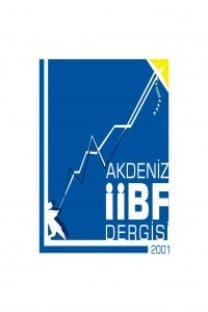EFFICIENCY OF ECONOMIC INTERVENTIONS OF GOVERNMENT
Öz The aim of the study is to measure the effect of government intervention on the economic output of countries. For this purpose, the efficiency of government intervention is measured in 55 countries, by using Data Envelopment Analysis which is one of the most appropriate method. Generally, it is found that the regulation tool is more determinant than the expenditure tool on the countries’ economic output, and the success level of government intervention is closely related to the countries’ development level.
EFFICIENCY OF ECONOMIC INTERVENTIONS OF GOVERNMENT
___
- Alesina, A., Özler S., Roubini N. ve Swagel P. (1996) “Political Instability and Economic Growth”, Journal of Economic Growth, 1, 189-211.
- Balassa, B. (1985) “Export Policym Choices and Economic Growth in developing Countries After the 1973 Oil Shock”, Journal of Development Economics, 18, 23-35.
- Banker, R.D. ve Morey R.C. (1986) “The Use of Categorical Variables in Data Envelopment Analysis”, Management Science, 32, 1613-1627.
- Banker, R.D., Conrad R.F. ve Strauss R.P. (1986) “A Comparative Application of DEA and Translog Methods: An Illustrative Study of Hospital Production”, Management Science, 32, 30-44.
- Barr, N. (1993) The Economics of the Welfare State, Standford.
- Barro, R. (1990) “Government Spending in a Simple Model of Endogenous Growth”, Journal of Political Economics, (98)5,103-117.
- Barro, R. (1991) “Economic Growth in a Cross Section of Countries”, Quarterly Journal of Economics,106, 407-443.
- Barro, R. (1996a) “Democracy and Growth”, Journal of Economic Growth, 1, 1-27.
- Barro, R. (1996b) “Institutions and Growth: An Introductory Essay”, Journal of Economic Growth, 1, 145-148.
- Barro, R. (1997) Determinants of Economic Growth: A CrossCountry Emprical Study, Cambridge.
- Barro, R. ve Sala-i Martin X. (1995) Economic Growth, New York.
- Charnes, A. ve Cooper W.W. (1962) “Programming with Linear Fractinal Functionals”, Naval Research Logistics Quarterly, 9, 3-4.
- Charnes, A. ve Cooper W.W. ve Rodes E. (1978) “Measuring Efficiency of Decision Making Units”, Journal of Operational Research, 2, 429-444.
- Charnes, A. ve Cooper W.W. ve Rodes E. (1979) “Short Communication: Measuring the Efficiency of Decision Making Units”, Journal of Operational Research, 3, 339.
- Chilingerian, J. ve Sherman H.D. (1994) “Evaluating and Marketing Efficiency Physicians Toward Compatitive Advantage”, Health Care Strategic Management,12, 16-19.
- Cingi, S. ve Tarım A. (2000) “Türk Bankacılık Sisteminde Performans Ölçümü DEA-Malquist TFP Endeksi Uygulaması”, Araûtırma Tebliİleri Serisi, Sayı:2000-01.
- Türk Bankalar Birliİi
- Deininger K. ve Squire L. (1996) “A New Data Set on Measuring Income Inequality”, World Bank Economic Review, (10) 3, 565-592.
- Delong, B. ve Shleifer A. (1993) “Prices and Merchants:European City Growth Before the Industrial Revolution”,Journal of Law and Economics, 36, 671-702.
- Farrell, M.J. (1957) “The Measurement of Productive Efficiency”, Journal of the Royal Statistical Society,Series A,120, 253-281.
- Ganley, J.A. ve Cubbin J.S. (1992) Public Sector Efficiency Measurement Applications of Data Envelopment Analysis,North Holland.
- Güran, M.C. (2000) Kamusal Müdahaleler ve Ekonomik Performans, (Yayınlanmamıû Doktora Tezi), Hacettepe Üniversitesi Sosyal Bilimler Enstitüsü, Ankara.
- Gwartney, J.D., R. Lawson R. ve Block W. (1996) Economic Freedom of the World 1975-1995, Vancouver.
- Harrison, A. (1996) “Openness and Growth: A Time Series CrossCoutry Analysis for Developing Countries”, Journal of Development Economics, 48, 419-447.
- Helliwel, J.F (1992) “Emprical Linkages Between Democracy and Economic Growth”, National Bureau of Economic Research, Working Paper No:4066.
- Johnson, B.T., Holmes K.R.ve Kirkpatrik M. (1999) Index of Economic Freedom, Washington.
- Knack S. ve Keefer P. (1995) “Institutions and Economic Performance: Cross Country Tests Using Alternative Institutional Measures”, Economics and Politics, (7) 3, 207-227.
- Knight M., Loayza N. ve Villanueva D. (1993) “Testing the Neoclassical Theory of Economic Growth”, IMF Staff Papers, (40) 3, 512-541.
- Lovell, K., Pastor J. ve Turner J. (1995) “Measuring Macroeconomic Performance in the OECD: A Comparison of European and non- European Countries”, European Journal of Operational Research, 87, 517-518.
- Lucas, R.E. (1988) “On the Mechanics of Developmnet Plannig”, Journal of Monetary Economics,22, 3-42.
- Mauro, P. (1995) “Corruption and Growth”, Quarterly Journal of Economics, 110, 681-712.
- Musgrave, R.A. ve Musgrave P. (1989) Public Finance in Theory and Practice, London.
- Rauch, J. (1995) “Bureaucracy, Infrastructure and Economic Growth: Evidence from US Cities During the Progressive Era”, The American Economic Review, 85, 968-979.
- Romer, P. (1986) “Increasing Returns and Long Run Growth”, Journal of Political Economy, 94, 1002-1037.
- Sherman, H.D. (1989) Service Organization Productivity Management, Ontario.
- Sherman, H.D. ve Gold F. (1985) “Bank Branch Operating Efficiency”, Journal of Banking and Finance, 9, 297-315.
- Shleifer A. ve Vishny R.W. (1993) “Corruption”, Quarterly Journal of Economics, 108, 599-617.
- Sudit, E.F. (1995) “Productivity Measurement in Industrial Operations”, European Journal of Operational Research,85, 435-453.
- Tarım, A. (2001) Veri Zarflama Analizi, Ankara.
- Wolf, C. (1988) Market and Governments, Cambridge.
- World Bank (1997) The State in a Changing World, New York.
- World Bank (1998) World Development Indicators, New York.
- World Bank (1999) World Development Indicators CD ROM, Washington.
- ISSN: 1302-9975
- Başlangıç: 2001
- Yayıncı: Akdeniz Üniversitesi
Sayıdaki Diğer Makaleler
EUROPEAN SECURITY AND DEFENCE POLICY AND TURKEY
A PARCH MODELLING OF THE IMKB INDEX
A FIELD RESEARCH ON THE ADAPTATION PROBLEM OF RETURNED EMIGRANTS’ CHILDREN
UN ESSAI D’ANALYSE DES RELATIONS ARMEE-POUVOIR DANS LES PAYS SOUS-DEVELOPPES
